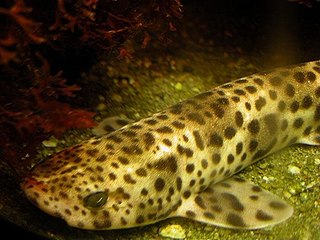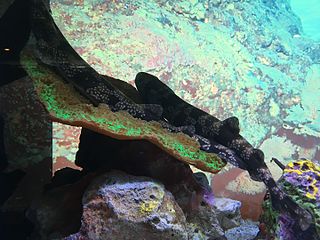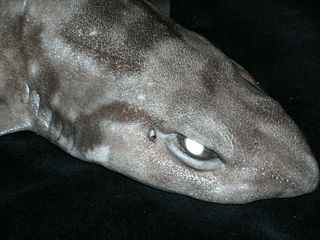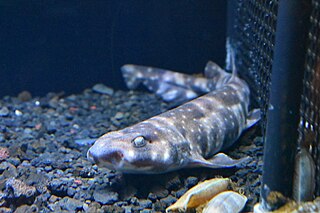
Catsharks are ground sharks of the family Scyliorhinidae. They are the largest family of sharks with around 160 species placed in 17 genera. Although they are generally known as catsharks, some species can also be called dogfish due to previous naming. However, a dogfish may generally be distinguished from a catshark as catsharks lay eggs while dogfish have live young. Like most bottom feeders, catsharks feed on benthic invertebrates and smaller fish. They are not harmful to humans. The family is paraphyletic, containing several distinct lineages that do not form a monophyletic group.

Scyliorhinus is a genus of catsharks in the family Scyliorhinidae. This genus is known in the fossil records from the Cretaceous period, late Albian age to the Pliocene epoch.

Galeus is a genus of catshark, belonging to the family Scyliorhinidae, commonly known as sawtail catsharks in reference to a distinctive saw-toothed crest of enlarged dermal denticles, found along the upper edges of their caudal fins. They are found in the Atlantic, the western and central Pacific, and the Gulf of California, inhabiting deep waters at or close to the sea floor. Members of this genus are rather small, slim sharks with firm bodies and thick, rough skin. Their heads are usually fairly long and pointed, and have large mouths with well-developed furrows at the corners. They have large pectoral and anal fins, and two similar dorsal fins placed well back. Many species are ornately patterned with dark saddles and/or blotches. Sawtail catsharks feed on various invertebrates and fishes, and may be either egg-laying or live-bearing. These harmless sharks are sometimes caught as bycatch but are of minimal commercial value.

The dwarf catshark is a catshark, belonging to the family Scyliorhinidae. It is found off the coast of southern Florida, the Bahamas, and Cuba and is also known as the whitespotted catshark and Cuban catshark.

The quagga catshark is a species of catshark, belonging to the family Scyliorhinidae. A small, slim-bodied shark reaching 37 cm (15 in) in length, it has a distinctive color pattern of narrow, dark brown vertical bars, which resemble those of the quagga. Its head is short and flattened, with a pointed snout tip that is not upturned.

The cloudy catshark is a common species of catshark, belonging to the family Scyliorhinidae. It is a bottom-dweller that inhabits rocky reefs in the northwestern Pacific Ocean, from the shore to a depth of 320 m (1,050 ft). Growing up to 50 cm (20 in) long, this small, slim shark has a narrow head with a short blunt snout, no grooves between the nostrils and mouth, and furrows on the lower but not the upper jaw. It is also characterized by extremely rough skin and coloration consisting of a series of dark brown saddles along its back and tail, along with various darker and lighter spots in larger individuals.

The nursehound, also known as the large-spotted dogfish, greater spotted dogfish or bull huss, is a species of catshark, belonging to the family Scyliorhinidae, found in the northeastern Atlantic Ocean. It is generally found among rocks or algae at a depth of 20–60 m (66–197 ft). Growing up to 1.6 m (5.2 ft) long, the nursehound has a robust body with a broad, rounded head and two dorsal fins placed far back. It shares its range with the more common and closely related small-spotted catshark, which it resembles in appearance but can be distinguished from, in having larger spots and nasal skin flaps that do not extend to the mouth.

The West African catshark is a catshark of the family Scyliorhinidae. It is found in the eastern Atlantic between latitudes 20° N and 17° S, at depths between 45 and 500 m. It can grow up to a length of 80 centimetres (31 in). At one time, the West African catshark was considered to be a subspecies of the nursehound, Scyliorhinus stellaris, but is now considered to be a separate species. The reproduction of this catshark is oviparous.

The Izu catshark is a species of catshark, family Scyliorhinidae, found only in the waters around Japan, at depths down to 100 m (328 ft). It can grow up to a length of 41 cm (16.1 in).

The whitesaddled catshark is a species of catshark, and part of the family Scyliorhinidae. It is found on the upper continental slope of the western central Atlantic Ocean, off the coasts of Honduras, Panama and Colombia, between latitudes 22° N and 9° N, at depths between 274 and 457 m. It can grow to a length of 47 cm (19 in). The reproduction of this catshark is oviparous but otherwise, little is known about its biology.

The freckled catshark is a catshark of the family Scyliorhinidae. It is found on the continental shelf and upper slope from the western Atlantic from western Venezuela, Suriname, Brazil, and Uruguay, between latitudes 11° N and 32° S. However, specimens from the northern part of this range probably refer to other species.

The brownspotted catshark is a rare catshark of the family Scyliorhinidae, found in the Indo-West Pacific between latitudes 11° N and 12° S. Its juvenile length is about 38 cm, but its adult size is mostly unknown. The reproduction of this catshark is oviparous.

The Comoro catshark is a rare catshark of the family Scyliorhinidae. The holotype and only specimen was taken from the Comoros Islands in the Indian Ocean, at a depth of 400 metres (1,300 ft). The Comoro catshark is not well-documented. The reproduction of this catshark is oviparous.

The yellowspotted catshark is a rare catshark of the family Scyliorhinidae. It is found in the southeast Atlantic, from Lüderitz, Namibia to central Natal, South Africa, between latitudes 0° and 37° S. It can grow up to a length of about 1.22 metres. The reproduction of this catshark is oviparous.

The small-spotted catshark, also known as the sandy dogfish, lesser-spotted dogfish, rough-hound or morgay, is a catshark of the family Scyliorhinidae. It is found on the continental shelves and the uppermost continental slopes off the coasts of Norway and the British Isles south to Senegal and in the Mediterranean, between latitudes 63° N and 12° N. It can grow up to a length of 1 m, and it can weigh more than 2 kg (4.4 lb). It is found primarily over sandy, gravelly, or muddy bottoms from depths of a few metres down to 400 m (1,300 ft). S. canicula is one of the most abundant elasmobranchs in the northeast Atlantic and Mediterranean Sea. The majority of the populations are stable in most areas.

The boa catshark is a catshark of the family Scyliorhinidae. It is found on the continental shelves and insular slopes of the Caribbean Sea and the Gulf of Mexico, between latitudes 20° N and 9° N, at depths between 330 and 675 m. It can grow up to a length of 54 cm. The reproduction of this catshark is oviparous.
Bythaelurus is a genus of deep-water catsharks and part of the family Scyliorhinidae. The genus Bythaelurus Compagno 1988 was first described as a subgenus of Halaelurus Gill 1862 based on several morphological characteristics including a soft body with thin skin, a bluntly rounded snout without a pointed, knob-like tip, and eyes not noticeably elevated on the dorsal surface of the head. Members of this genus are generally found in deep water and have more somber body coloration.

Scyliorhinus meadi, the blotched catshark, is a little-known species of catshark, and part of the family Scyliorhinidae, found in the western central Atlantic Ocean. It inhabits banks of deep-sea coral at depths of 329–548 m (1,079–1,798 ft), feeding on cephalopods, shrimp, and bony fishes. This species can be identified by its wide body and head, and the dark saddle-like markings on its back. It also has small spots that fluoresce yellow under a blue light. Adult blotched catsharks have not been observed; the largest immature specimen is 49 cm (19 in) long. Like other catsharks, it is believed to be oviparous. This species is not dangerous to humans and has no commercial significance.
The dark freckled catshark is a catshark of the family Scyliorhinidae. It is found in Northeastern and Southeastern Brazil. This species differs from Scyliorhinus besnardi, Scyliorhinus haeckelii group and Scyliorhinus hesperius, in background coloration, head width, sexual maturity, and in cranial and body proportions.

The cinder cloudy catshark is a species of catshark from the Pacific Ocean; all specimens identified have been from the area around the Izu Islands, Japan. The species is a close relative of the cloudy catshark, and the overall appearance is similar. The species was first identified in 2022 as bycatch of the splendid alfonsino fishery.

















